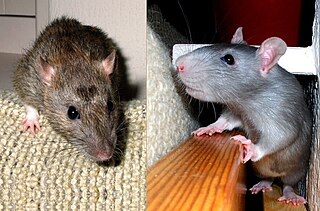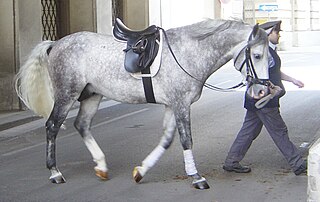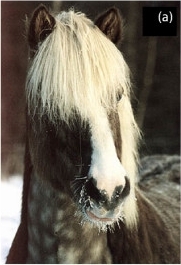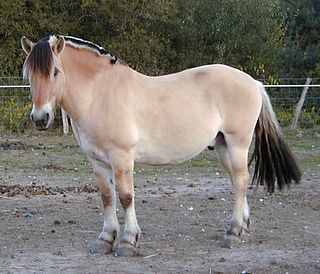
Palomino is a genetic color in horses, consisting of a gold coat and white mane and tail; the degree of whiteness can vary from bright white to yellow. The palomino color derived from the inter-breeding of Spanish horses with those from the United States. Genetically, the palomino color is created by a single allele of a dilution gene called the cream gene working on a "red" (chestnut) base coat. Palomino is created by a genetic mechanism of incomplete dominance, hence it is not considered true-breeding. However, most color breed registries that record palomino horses were founded before equine coat color genetics were understood as well as they are today, therefore the standard definition of a palomino is based on the visible coat color, not heritability nor the underlying presence of the dilution gene.

A dilution gene is any one of a number of genes that act to create a lighter coat color in living creatures. There are many examples of such genes:

Cat coat genetics determine the coloration, pattern, length, and texture of feline fur. The variations among cat coats are physical properties and should not be confused with cat breeds. A cat may display the coat of a certain breed without actually being that breed. For example, a Neva Masquerade could wear point coloration, the stereotypical coat of a Siamese.

Lethal white syndrome (LWS), also called overo lethal white syndrome (OLWS), lethal white overo (LWO), and overo lethal white foal syndrome (OLWFS), is an autosomal genetic disorder most prevalent in the American Paint Horse. Affected foals are born after the full 11-month gestation and externally appear normal, though they have all-white or nearly all-white coats and blue eyes. However, internally, these foals have a nonfunctioning colon. Within a few hours, signs of colic appear; affected foals die within a few days. Because the death is often painful, such foals are often humanely euthanized once identified. The disease is particularly devastating because foals are born seemingly healthy after being carried to full term.

Buckskin is a colour of horse that is commonly misconceived for being a breed of horse. Buckskins coloring is a hair coat color referring to a color that resembles certain shades of tanned deerskin. Similar colors in some breeds of dogs are also called buckskin. The horse has a tan or gold colored coat with black points. Buckskin occurs as a result of the cream dilution gene acting on a bay horse. Therefore, a buckskin has the Extension, or "black base coat" (E) gene, the agouti gene (A) gene, which restricts the black base coat to the points, and one copy of the cream gene (CCr), which lightens the red/brown color of the bay coat to a tan/gold.

A gray horse has a coat color characterized by progressive depigmentation of the colored hairs of the coat. Most gray horses have black skin and dark eyes; unlike some equine dilution genes and some other genes that lead to depigmentation, gray does not affect skin or eye color. Gray horses may be born any base color, depending on other color genes present. White hairs begin to appear at or shortly after birth and become progressively more prevalent as the horse ages as white hairs become intermingled with hairs of other colors. Graying can occur at different rates—very quickly on one horse and very slowly on another. As adults, most gray horses eventually become completely white, though some retain intermixed light and dark hairs.

The cream gene is responsible for a number of horse coat colors. Horses that have the cream gene in addition to a base coat color that is chestnut will become palomino if they are heterozygous, having one copy of the cream gene, or cremello, if they are homozygous. Similarly, horses with a bay base coat and the cream gene will be buckskin or perlino. A black base coat with the cream gene becomes the not-always-recognized smoky black or a smoky cream. Cream horses, even those with blue eyes, are not white horses. Dilution coloring is also not related to any of the white spotting patterns.

The champagne gene is a simple dominant allele responsible for a number of rare horse coat colors. The most distinctive traits of horses with the champagne gene are the hazel eyes and pinkish, freckled skin, which are bright blue and bright pink at birth, respectively. The coat color is also affected: any hairs that would have been red are gold, and any hairs that would have been black are chocolate brown. If a horse inherits the champagne gene from either or both parents, a coat that would otherwise be chestnut is instead gold champagne, with bay corresponding to amber champagne, seal brown to sable champagne, and black to classic champagne. A horse must have at least one champagne parent to inherit the champagne gene, for which there is now a DNA test.

The silver or silver dapple (Z) gene is a dilution gene that affects the black base coat color and is associated with Multiple Congenital Ocular Abnormalities. It will typically dilute a black mane and tail to a silvery gray or flaxen color, and a black body to a chocolaty brown, sometimes with dapples. It is responsible for a group of coat colors in horses called "silver dapple" in the west, or "taffy" in Australia. The most common colors in this category are black silver and bay silver, referring to the respective underlying coat color.

Equine coat color genetics determine a horse's coat color. Many colors are possible, but all variations are produced by changes in only a few genes. Bay is the most common color of horse, followed by black and chestnut. A change at the agouti locus is capable of turning bay to black, while a mutation at the extension locus can turn bay or black to chestnut.

The dun gene is a dilution gene that affects both red and black pigments in the coat color of a horse. The dun gene lightens most of the body while leaving the mane, tail, legs, and primitive markings the shade of the undiluted base coat color. A dun horse always has a dark dorsal stripe down the middle of its back, usually has a darker face and legs, and may have transverse striping across the shoulders or horizontal striping on the back of the forelegs. Body color depends on the underlying coat color genetics. A classic "bay dun" is a gray-gold or tan, characterized by a body color ranging from sandy yellow to reddish brown. Duns with a chestnut base may appear a light tan shade, and those with black base coloration are a smoky gray. Manes, tails, primitive markings, and other dark areas are usually the shade of the undiluted base coat color. The dun gene may interact with all other coat color alleles.

The Fjord or Norwegian Fjord Horse is a relatively small but very strong horse breed from the mountainous regions of western Norway. It is an agile breed of light draught horse build. It is always dun in colour, with five variations in shade recognised in the breed standard. One of the world's oldest breeds, it has been used for hundreds of years as a farm horse in Norway, and in modern times is popular for its generally good temperament. It is used both as a harness horse and under saddle.

Chestnut is a hair coat color of horses consisting of a reddish-to-brown coat with a mane and tail the same or lighter in color than the coat. Chestnut is characterized by the absolute absence of true black hairs. It is one of the most common horse coat colors, seen in almost every breed of horse.

Horses exhibit a diverse array of coat colors and distinctive markings. A specialized vocabulary has evolved to describe them.

A white horse is born predominantly white and stays white throughout its life. A white horse has mostly pink skin under its hair coat, and may have brown, blue, or hazel eyes. "True white" horses, especially those that carry one of the dominant white (W) genes, are rare. Most horses that are commonly referred to as "white" are actually "gray" horses whose hair coats are completely white. Gray horses may be born of any color and their hairs gradually turn white as time goes by and take on a white appearance. Nearly all gray horses have dark skin, except under any white markings present at birth. Skin color is the most common method for an observer to distinguish between mature white and gray horses.

Sabino describes a distinct pattern of white spotting in horses. In general, Sabino patterning is visually recognized by roaning or irregular edges of white markings, belly spots, white extending past the eyes or onto the chin, white above the knees or hocks, and "splash" or "lacy" marks anywhere on the body. Some sabinos have patches of roan patterning on part of the body, especially the barrel and flanks. Some sabinos may have a dark leg or two, but many have four white legs. Sabino patterns may range from slightly bold face or leg white markings—as little as white on the chin or lower lip—to horses that are fully white.

Smoky black or black carrying cream is a coat color of horses which has the same phenotype as black. Smoky black is produced by the action of a heterozygous cream gene on an underlying black coat color. Therefore, smoky black is a member of the cream family of coat color dilutions, and found in horse populations that have other cream-based colors such as palomino, buckskin, perlino, cremello and smoky cream. All smoky blacks must have at least one parent with the cream gene, and a smoky black can only be verified through DNA testing or parentage. Smoky black has been mistaken for faded black, dark bay or brown, grullo or even liver chestnut.

The genetic basis of coat colour in the Labrador Retriever has been found to depend on several distinct genes. The interplay among these genes is used as an example of epistasis.

Dominant white (W) is a group of genetically related coat color alleles on the KIT gene of the horse, best known for producing an all-white coat, but also able to produce various forms of white spotting, as well as bold white markings. Prior to the discovery of the W allelic series, many of these patterns were described by the term sabino, which is still used by some breed registries.

Dogs have a wide range of coat colors, patterns, textures and lengths. Dog coat color is governed by how genes are passed from dogs to their puppies and how those genes are expressed in each dog. Dogs have about 19,000 genes in their genome but only a handful affect the physical variations in their coats. Most genes come in pairs, one being from the dog's mother and one being from its father. Genes of interest have more than one expression of an allele. Usually only one, or a small number of alleles exist for each gene. In any one gene locus a dog will either be homozygous where the gene is made of two identical alleles or heterozygous where the gene is made of two different alleles.




















